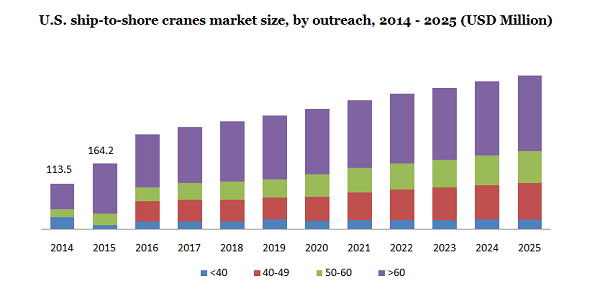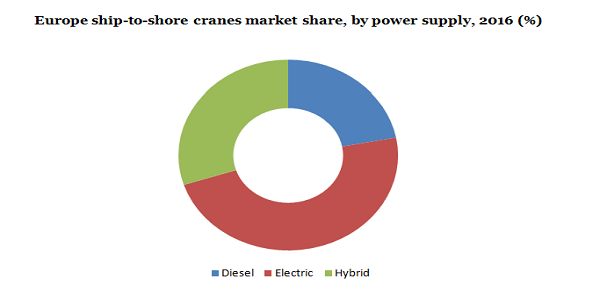- US: +1-408-610-2300
- Toll Free: +1-866-831-4085
- Become a Client
The global ship-to-shore cranes market size was worth USD 2.17 billion in the year 2016 and is anticipated to significantly grow over the projected period. Factors like rising container traffic, transshipment activities, and vessel sizes are expected to be the major drivers for market growth. The optimistic and steady market scenarios have resulted in numerous initiatives in the port industry for the advancement of ship-to-shore (STS) cranes along with depth, quay, and other cranes (RMGs/RTGs).
The Asia Pacific held the largest market in 2018 and the Middle East and Latin America are also emerging as the leading markets. One of the major features of these regions includes the surging private investment for infrastructural development and in the Greenfield projects. However, the volatile economic conditions and huge investment costs pertained by these cranes can cause hindrance for market growth to some extent.

The key players emphasize the capacity management of ship-to-shore cranes when the level of the container increases through strengthening, extending, and heightening them. Advancements in traditional machines are mostly preferred by companies as it reduces costs.
The rising demand for maritime trade was served with the expansion of the Panama Canal by developing an additional route to cope up with the container vessel traffic. Moreover, it has resulted in the widespread reach of ports in regions like Latin America. It has also strengthened exports to North America and the Asia Pacific. Moreover, port expansion has supported the installation of STS cranes to monitor the container.
Automation serves as a safety provider for drivers and helps in the efficient management of the container. Technologies like Ship Profiling System (SPS) and Electronic Load System (ELC) allow protected shipment of containers to a port.
The >60 ship-to-shore cranes are anticipated to register the fastest growth with a CAGR of 6.4% from 2017 to 2025 due to the continuous advances in existing cranes for a better handling capacity.
Wider outreach allows STS Crane to initiate faster transport with lesser moves. Asia Pacific is predicted to witness a significant boost of the>60 STS crane due to the higher number of containers. As per the World Bank Organization, container traffic was 11,655,635 TEU in India, in 2014, and the number is expected to increase by 2025. Therefore, installation in this region is anticipated to grow in the upcoming years.
Electric emerged as the largest segment worth USD 1.06 billion in 2016. It is expected to exhibit the fastest CAGR of 5.8% from 2017 to 2025.

Regular maintenance for Electric ship-to-shore cranes is not required that saves costs for the company. They also prevent the use of hydraulic oils and engines since they run on electricity. Stringent government rules to prevent and control pollution have resulted in increased use of these machines. Technological upgrades have allowed minimal energy consumption, thereby, impelling the demand.
Asia Pacific is projected to account for the fastest growth with a CAGR of above 5.8% from 2017 to 2025. The surging demand has led to a steady rise in container traffic in this region, which is expected to strengthen port expansion in different parts of the Asia Pacific.
STS cranes serve as an integral part of the port infrastructure that is an important aspect of logistics transport globally. The rising container traffic in the Asia Pacific has impelled governments in this region to increase investment in the port expansion which is expected to surge machine installation for better handling capacity.
Some of the key players are Konecranes, Kalmar, Shanghai Zhenhua Heavy Industries Co., Ltd., Kranunion GmbH, Noell Crane Systems (China) Limited, Wison Group, Liebherr-International AG, MAC PORT MacchineOperatriciPortualis.r.l, Anupam Industries Limited, and SANY Group Co., Ltd.
The STS cranes market consists of fewer players holding large market shares. Higher competition hinders the entry of new players. Partnerships or acquisitions with big companies are the key strategy used by many companies to combat competition.
Market players like, Shanghai Zhenhua Heavy Industries Co., Ltd., used an unconventional supply chain mechanism that involves transferring the entire crane to the place. The approach enables time-saving and lowers installation costs.
|
Attribute |
Details |
|
The base year for estimation |
2016 |
|
Actual estimates/Historical data |
2014 - 2016 |
|
Forecast period |
2017 - 2025 |
|
Market representation |
Revenue in USD Million & CAGR from 2017 to 2025 |
|
Regional scope |
North America, Europe, Asia Pacific, Latin America, and Middle East & Africa |
|
Country Scope |
U.S., U.K., Turkey, China, India, Japan, Brazil, and Mexico |
|
Report coverage |
Revenue forecast, company share, competitive landscape, and growth factors and trends |
|
15% free customization scope (equivalent to 5 analyst working days) |
If you need specific information, which is not currently within the scope of the report, we will provide it to you as a part of the customization |
This report forecasts revenue growth at global, regional, and country levels and provides an analysis of the latest industry trends in each of the sub-segments from 2014 to 2025. For the purpose of this study, Million Insights has segmented the global ship-to-shore cranes market report based on outreach, power supply, and region:
• Outreach Outlook (Revenue, USD Million; 2014 - 2025)
• <40
• 40-49
• 50-60
• 60+
• End User Outlook (Revenue, USD Million; 2014 - 2025)
• Diesel
• Electric
• Hybrid
• Regional Outlook (Revenue, USD Million; 2014 - 2025)
• North America
• U.S.
• Europe
• U.K.
• Turkey
• the Asia Pacific
• China
• India
• Japan
• Latin America
• Brazil
• Mexico
• MEA


Research Support Specialist, USA